
I recently posted that the United States was the dominant player in the naval/air conflict against Japan while Britain and the Commonwealth made limited, but tangible, contributions to this effort.
This American dominance was not the case in the ground war where the United States and British Empire actually attained relative parity in their competing efforts against the Japanese. Part of this is demonstrated by the fact that both entities contributed similarly sized forces to the conflict. During the fighting in Southeast Asia and the South Pacific, the British Empire employed as many divisions in active combat against the Japanese as did the United States. To be specific, a total of 27 British and Commonwealth divisions (consisting of four British, twelve Indian, seven Australian, three African and one New Zealand) saw service at one point or another during the war against Japan compared to an identical number of American divisions that saw similar service during the conflict.
Even more compelling was the fact that both entities attain similar results against the Japanese. In 1949 the Japanese government did an analysis of Japanese casualties sustained during the war as documented in Japan Statistical Year-Book, 1949, p. 1,058. This analysis was far from complete as it did not account for 240,000 army personnel who went missing during the conflict and only counted wounded personnel who received pensions. Still, this examination documented a total of 1,140,429 Japanese army personnel killed with a further 295,247 wounded during the period of December 1941 to December 1946. Of these, 407,537 of the ground fatalities and 154,225 of the wounded were determined to have occurred in operations confronting British, Australian or Dutch forces thus equating to 35.7 and 52.2 percent of the total losses respectively. By comparison, the study assigned the figures killed and wounded by American forces at 485,717 and 34,679 respectively thus constituting 42.6 and 11.7 percent of the total losses. In combining the killed and wounded together, the analysis put the overall casualties incurred against British, Australian and Dutch forces at 561,762 while those explicitly incurred against American forces amounted to 520,396. Finally, as a point of comparison, Japanese losses sustain against the Chinese during this period were 202,958 killed and 88,920 wounded for a combined 291,878 total casualties.
While again stipulating that these figures are incomplete, this data clearly shows that British and Commonwealth forces played a substantially greater role in the theatre’s ground combat than in other aspects of their regional war effort. In doing so, they tended to engage in a different kind of fighting than their American counterparts. In particular, British and Commonwealth forces tended to engage in more traditional ground operations that were fought over wide areas for extended periods of time. The most prevalent examples of this were the campaigns in Burma and Papua New Guinea, which were protracted undertakings lasting years over contested areas stretching for hundreds of thousands of square miles. Given this reality, these were often battles of manoeuvre as both sides had ample territory in which to advance or retreat. Likewise, much of this took place over extremely harsh terrain that taxed the logistical capabilities of the competing forces.
By comparison, much of the American fighting consisted of island warfare in which the forces involved fought intense battles of relatively short durations in geographically limited locations against isolated Japanese garrisons that had minimal opportunities to manoeuvre, disengage or receive reinforcements. Accordingly, these American operations were often battles of annihilation against a set enemy in a confined location. The differing natures of these campaigns explain why the Japanese suffered a larger percentage of wounded facing British and Australian units than they did facing the Americans. Likewise, it is safe to assume that a far larger percentage of Japanese fatalities incurred in the British/Commonwealth areas were the result of disease and starvation as opposed to direct combat action.
Based upon this data, it is clear that British and Commonwealth forces played a much greater role in the ground war against Japan than they did in the corresponding naval/air conflict. Pictured here (left) is a 3-inch mortar team of the British 36th Division engaging Japanese positions in Burma in 1944. Stubbs A (Sgt), No 9 Army Film & Photographic Unit, Public Domain. Also pictured (right) are Australian troops of the 2/12 Infantry Battalion advancing in Borneo in 1945. Unknown Author, Public Domain. For more information on this and other related topics, see Forgotten War, the British Empire and Commonwealth’s Epic Struggle Against Imperial Japan, 1941-1945.













Leave a Reply